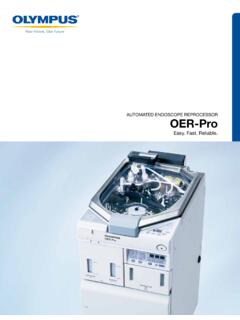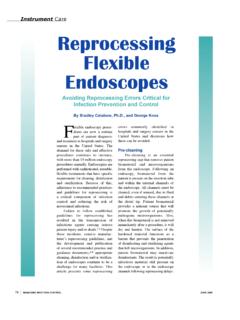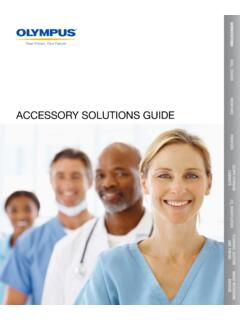Transcription of EVIS EXERA II DUODENOVIDEOSCOPE OLYMPUS TJF Q180V
1 Single use soft brush (MAJ-1888)Refer to the endoscope s companion manual, the OPERATION MANUAL with your endoscope model listed on the cover, for operation : CAUTION:Federal law restricts this device to sale by or on the order of a EXERA II DUODENOVIDEOSCOPEOLYMPUS TJF TYPE Q180 VAccessories: Water resistant cap (MH-553) Chain for water-resistant cap (MAJ-1119) Biopsy valve (MB-358) Suction valve (MH-443) Air/water valve (MH-438) Mouthpiece (MB-142) Suction cleaning adapter (MH-856) Channel plug (MH-944) Channel cleaning brush (BW-20T) Injection tube (MH-946) Single use channel cleaning brush (BW-201T) Single use channel-opening cleaning brush (MAJ-1339) AW channel cleaning adapter (MH-948) Single use combination cleaning brush (BW-412T) Single use soft brush (MAJ-1888)MH-553MH-438MH-443MB-358MB-142 MAJ-1119MH-856MH-944MH-946 MAJ-1339BW-20 TBW-201 TMH-948BW-412 TMAJ-1888 Revision HistoryNote: The Revision History shows the latest of ChangesRC2409 01 March, 2015 CoverSection , , and and 7 Single use soft brush (MAJ-1888) information.
2 Updated WARNING statements for MAJ-1888 and using an MAJ-1888 MAJ-1888 and AER MAJ-1888 Aspirate water Detach the endoscope from the light source Equipment needed chart and CAUTION for MAJ-1888, Step 5 on page 69, and added Brush and flush the forceps elevator recess Flush all channels and around the forceps elevator with disinfectant solution Rinse the endoscope and accessories section; the Alcohol flush WARNING statements for 09 February, 2015 ContentsiEVIS EXERA II TJF TYPE Q180V REPROCESSING MANUALC ontentsChapter 1 General Policy .. of cleaning, disinfection, and words .. before the first use .. and storage after use .. before patient 2 Function and Inspection of the Accessories for resistant cap (MH-553) .. plug (MH-944).. tube (MH-946) .. cleaning brush (BW-20T).. cleaning adapter (MH-856) .. channel cleaning adapter (MH-948) .. use channel cleaning brush (BW-201T).. use channel-opening cleaning brush (MAJ-1339).
3 Use combination cleaning brush (BW-412T) .. Single use soft brush (MAJ-1888).. Chain for water-resistant cap (MAJ-1119) ..27 Chapter 3 Compatible Reprocessing Methods and Chemical Agents .. (for reprocessing) .. water .. oxide gas sterilization (autoclaving) ..33 ContentsiiEVIS EXERA II TJF TYPE Q180V REPROCESSING MANUALC hapter 4 Reprocessing Workflow for the Endoscope and Accessories .. for manually cleaning and disinfecting the endoscope and accessories .. for cleaning and disinfecting the endoscope and accessories using an AER .. for manually cleaning and sterilizing the endoscope and accessories ..40 Chapter 5 Reprocessing the Endoscope (and related reprocessing accessories) .. the equipment for reprocessing .. the endoscope and testing of the endoscope .. cleaning the endoscope and disinfecting the endoscope and accessories .. the endoscope and accessories following the endoscope and accessories ..94 Chapter 6 Reprocessing the cleaning the accessories.
4 Disinfecting the the accessories following disinfection .. the 7 Reprocessing endoscopes and Accessories using an automated Endoscope 106 Chapter 8 Storage and Disposal .. the disinfected endoscope and accessories .. the sterilized endoscope and accessories ..111 Chapter 1 General Policy1 EVIS EXERA II TJF TYPE Q180V REPROCESSING MANUALC hapter 1 General This manual contains the cleaning, disinfection, and sterilization methods recommended by OLYMPUS for the endoscopes and accessories listed on the front cover. This instruction manual contains essential information on reprocessing endoscopes and accessories safely and effectively. Before reprocessing, thoroughly review this manual and the manuals for the reprocessing equipment and chemicals that will be used for reprocessing. Reprocess all the devices as instructed. Note that the complete instruction manual set for the endoscope and accessories consists of this manual and the OPERATION MANUAL with your endoscope model listed on the cover.
5 Both manuals accompanied the endoscope at shipment. Keep this manual and all related manuals in a safe and accessible location ( , in the reprocessing area). If you have any questions or comments about any information in this manual, or if a problem occurs while reprocessing that cannot be solved, contact 1 General PolicyEVIS EXERA II TJF TYPE Q180V REPROCESSING of cleaning, disinfection, and sterilizationThe medical literature reports incidents of cross-contamination resulting from improper cleaning, disinfection, or sterilization. It is strongly recommended that all individuals engaged in reprocessing closely observe all instructions given in this manual and the manuals for all ancillary equipment, and have a thorough understanding of the following items: Professional health and safety policies of your hospital Instruction manuals for the endoscope, accessories, and all the other reprocessing equipment Structure and handling of endoscope and accessories Handling of pertinent chemicalsWhen selecting appropriate methods and conditions for cleaning and disinfection and sterilization, follow the policies at your institution, applicable national laws and standards, and professional society guidelines and recommended practices, in addition to the instructions given in this wordsThe following signal words are used throughout this manual.
6 Indicates a potentially hazardous situation which, if not avoided, could result in death or serious a potentially hazardous situation which, if not avoided, may result in minor or moderate injury. It may also be used to alert against unsafe practices or potential equipment additional helpful 1 General Policy3 EVIS EXERA II TJF TYPE Q180V REPROCESSING An insufficiently cleaned, disinfected, or sterilized endoscope and/or accessories may pose an infection control risk to the patients and/or operators who contact them. All disinfection methods (whether performed manually or by an automated endoscope reprocessor), and all sterilization methods (whether performed by ethylene oxide gas or steam) require thorough prior cleaning of the instrument being reprocessed. If the equipment is not adequately cleaned prior to disinfection/sterilization, these processes will be ineffective. Immediately after each patient procedure and before disinfection/sterilization, thoroughly clean the endoscope and the accessories used with the endoscope.
7 All channels of the endoscope, including the instrument channel and all accessories used with the endoscope during the patient procedure, such as all valves, must be cleaned and high-level disinfected or sterilized after each patient procedure, even if the channels or accessories were not used during the patient procedure. Insufficient cleaning and disinfection or sterilization of these components may pose an infection control risk to patients and/or operators. Disinfectant solutions are hazardous. After disinfection, rinse all external surfaces and channels of the endoscope and accessories thoroughly with water to remove residual disinfectant solution. The results of sterilization depend on various factors. These factors include how the equipment was packaged, and the placing and loading of the package in the sterilization device. Verify the sterilization process using biological and/or chemical indicators. Follow the guidelines for sterilization issued by national authorities, professional organizations and infection control professionals, as well as the instruction manual for the sterilization 1 General PolicyEVIS EXERA II TJF TYPE Q180V REPROCESSING MANUAL Establish an internal system of identifying contaminated versus reprocessed endoscopes and accessories to prevent both mix-ups and cross-contamination.
8 Touching a reprocessed endoscope and/or accessories with contaminated gloves or placing them on a contaminated hanger or surface, including letting them touch the floor, will recontaminate them. Prior to each patient procedure, confirm that the endoscope and accessories have been properly reprocessed and stored. If there are any doubts or questions, reprocess them again before the patient procedure, following the instructions given in this manual. Perform a leakage test on the endoscope after each precleaning procedure. Do not use the endoscope if a leak is detected. Use of an endoscope with a leak may cause a sudden loss of the endoscopic image, damage to the bending mechanism, or other malfunctions. Use of a leaking endoscope may also pose an infection control Store alcohol in an airtight container. Alcohol stored in an open container may cause a fire hazard and may result in a loss of efficacy due to testerChapter 1 General Policy5 EVIS EXERA II TJF TYPE Q180V REPROCESSING MANUAL Do not use the AW channel cleaning adapter (MH-948) for patient procedures.
9 It will cause continuous insufflation and could result in patient The accessories listed on the front cover of this manual are consumables, meaning that these accessories cannot be refurbished or repaired and are intended to be replaced once they show any signs of wear. Should any irregularity be observed, use a replacement accessory instead. Using defective accessories may cause equipment malfunction, reduce the efficacy of reprocessing, present a risk to patients and/or operators, or damage the endoscope and/or accessories. Single-use brushes, such as the single use channel cleaning brush (BW-201T), the single use combination cleaning brush (BW-412T), the single use channel-opening cleaning brush (MAJ-1339), and the single use soft brush (MAJ-1888), are designed for cleaning only one endoscope and its related accessories. Dispose of the single-use brush immediately after use. Using a single-use brush to clean multiple endoscopes and/or accessories may reduce its cleaning efficacy and may damage the brush leading to brush breakage or endoscope and/or accessory channel cleaning adapter (MH-948)6 Chapter 1 General PolicyEVIS EXERA II TJF TYPE Q180V REPROCESSING MANUAL Patient debris and reprocessing chemicals are hazardous.
10 To guard against contact with dangerous chemicals and potentially infectious material, wear appropriate personal protective equipment during cleaning, disinfection, and sterilization. Such protective equipment should include appropriate eyewear, face mask, cap, moisture-resistant clothing, shoe covers, and chemical-resistant gloves that fit properly and are long enough to prevent skin exposure. The reprocessing room must be adequately ventilated. Adequate ventilation protects against the buildup of toxic chemical fumes. Always remove contaminated personal protective equipment before leaving the reprocessing area to prevent contamination from spreading. Only OLYMPUS -recommended or OLYMPUS -endorsed automated endoscope reprocessors (AERs) have been validated by OLYMPUS . When using an AER that is not recommended by OLYMPUS , the manufacturer of the AER is responsible for validating compatibility of the AER with each OLYMPUS endoscope and accessory. Before using an AER, confirm that it is capable of reprocessing the endoscope including all channels, the forceps elevator recess, and accessories.




